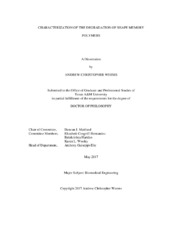| dc.description.abstract | Shape memory polymer (SMP) polyurethanes have been proposed for a variety of vascular devices due to their biocompatibility, stimuli-responsiveness, and tunable properties. While this technology shows promise, a primary limitation for translation of these SMPs into the clinic is a lack of understanding of the degradation behavior and stability.
Characterization of the degradation of these SMPs revealed excellent hydrolytic stability although the presence of tertiary amines results in a rapid oxidatively-induced mass loss over time. The mechanism of degradation was found to be the scission of the tertiary amines, producing secondary amines, primary amines, aldehydes and carboxylic acids. This understanding of degradation was then used to assess the toxicity risks for SMP implants, and it was found that despite degradation these SMPs may possess minimal risks as vascular implants.
One of the goals in medical devices is biostability, or relatively minimal mass loss over time. One method of tailoring oxidative mass loss was the use of antioxidants. Bulk inclusion of antioxidants resulted in tunability of pore size, mechanical properties, shape recovery kinetics, and oxidative resistance. A limitation of this method was the retention of antioxidants in the SMP matrix after cleaning the material post-synthesis, as determined from gas-chromatography mass spectrometry (GCMS). Synthesis and incorporation of polyurethane microparticles was used to improve the retention of antioxidants, determined by gravimetric comparisons. Additionally, while the inclusion of antioxidants resulted in various property changes, SMP composites containing the particles possessed similar scaffold pore size, shape recovery kinetics, and mechanical properties while displaying improved oxidative stability.
Further increase of the SMPs’ biostability was achieved through chemical modification of the polymer structure, with glycerol and isocyanurate groups examined. Glycerol was found to improve the oxidative resistance, resulting in SMPs with lifespans of ca 5 years when sufficient concentrations of glycerol were used. Isocyanurate-based SMPs are predicted to have lifespans extending potentially to nearly 20 years.
The presented work demonstrates the degradation behavior, toxicity risks, and mechanism for SMPs containing tertiary amines. This work is then applied for further tuning oxidation by the biostability through chemical and physical means, including new covalently added monomers and macromers, as well as composite synthesis. This work supports the concept of SMP-based vascular occlusion materials, and it is hoped that these studies will aid in the translation of such devices into clinics in the near future. | en |


